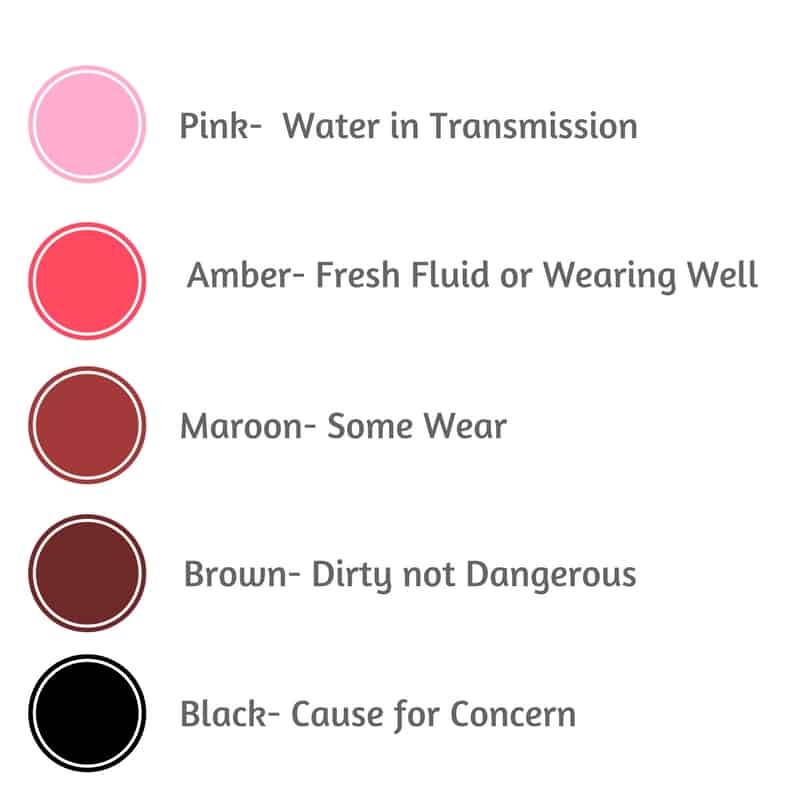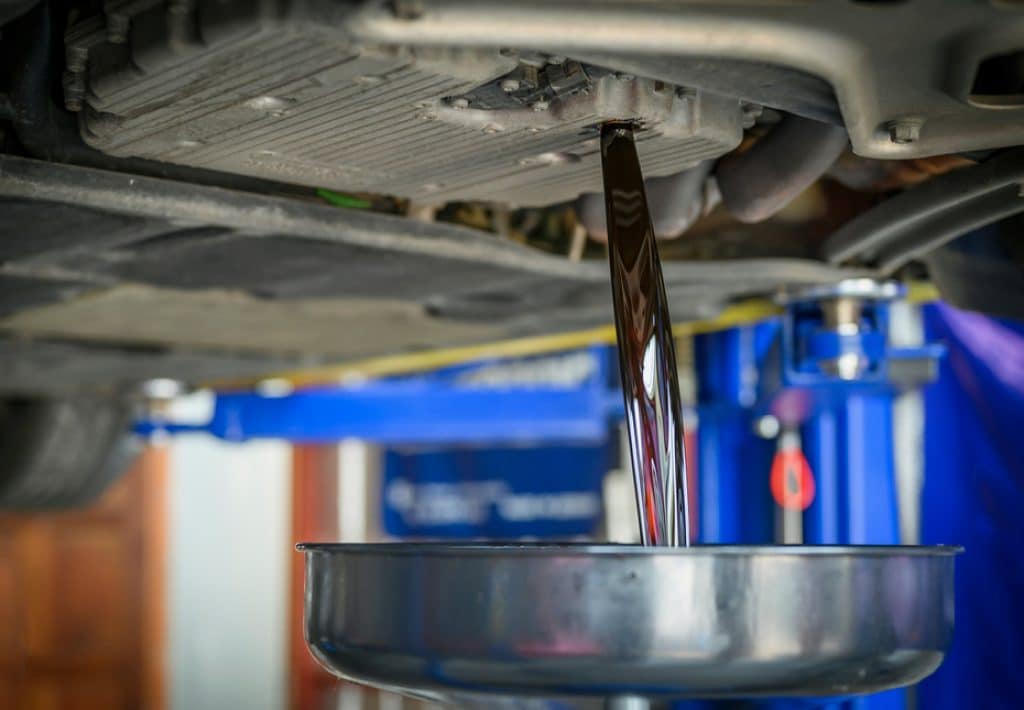What’s in a color? The answer is a ton of information when it comes to transmission fluid color. It is one of the best ways to tell the overall health of your transmission.
What does healthy transmission fluid look like? The short answer is a nice amber color. And that is assuming that you even have a manufacturer that starts with amber transmission fluid.
There are some vehicles that use other colors, but for the most part, they all use a transmission fluid that starts with some sort of bright red clear color.

| Transmission Fluid Color | What it Means |
|---|---|
| Red | New or clean transmission fluid. Good condition. |
| Light Brown | Normal wear and tear. Fluid may need to be changed soon. |
| Dark Brown | Fluid is old and may need to be changed. |
| Pink | Coolant is mixing with the transmission fluid. May indicate a leak in the transmission cooler or radiator. |
| Milky | Water is mixing with the transmission fluid. May indicate a leak in the transmission cooler or radiator. |
| Black | Fluid is burnt and needs to be changed immediately. May indicate a serious problem with the transmission. |
| Gray | May indicate metal shavings in the fluid, which could be a sign of internal transmission damage. |
Transmission Fluid Color Chart
Here is a chart of transmission fluid colors. You can use it to help you identify if there are any issues with your transmission fluid.
This chart assumes that the color your transmission fluid started with was red, which would describe almost all transmission fluid.

All bets are off once the transmission fluid leaves the bottle. As soon as it enters the case, it gets to work doing many jobs that are required of it. The fluid will begin to darken in color right away. This changing of the color doesn’t necessarily mean that there’s anything wrong.
There is simply an amazing amount that you can learn about a vehicle by looking at the transmission fluid. Just like motor oil, automatic transmission fluid gets darker with age. This in itself does not necessarily indicate a problem. Heat can cause ATF to darken over time.
Light Amber or Red Colored Fluid
The red color that you see in transmission fluid is from a dye added to it. Without it there would be almost no color to the fluid at all! Don’t be deceived if your fluid looks great. The color of the fluid is not an indication of transmission wear or the last time that it was serviced.
So, if your transmission is slipping, or it is due for service anyway, don’t let the color fool you. That being said, red is an indication of a healthy transmission.
Is transmission fluid red?
Most transmission fluid is red. There are dyes that are put into it to give it its red color. Theoretically, transmission fluid can be almost any color.
Notable exceptions would be B & M ATF, which is blue, or Mercedes transmission fluid, which can also be blue. It is very rare for a transmission fluid to not be red. Even royal purple transmission fluid is red.
Why is transmission fluid red?
Transmission Fluid is red due to the dyes that are put in it to help differentiate it from other fluids in the vehicle. This provides a couple of benefits.
- The red color allows you to find where it is leaking from more easily.
- Red transmission fluid is easy to tell apart from oil; this eliminates any confusion when trying to figure out why your transmission is leaking.
Maroon Transmission Fluid
When you check your transmission fluid, it appears as a nice maroon color, which is an indication of fluid that has been in the case for quite a few miles.
Heat causes the dye in the fluid to change color and get darker. Maroon fluid is usually just fine. In fact, some ATFs even come that dark straight out of the bottle.
Brown Transmission Fluid
If you are having difficulty distinguishing between the color of your transmission fluid and motor oil, then you officially have dirty transmission fluid. Dirty does not mean dangerous, though, and is not cause for alarm by itself.
If the only thing that appears to be wrong is that the transmission itself is in need of proper servicing.
You’ll see the situation often where someone is looking to buy a car, and they are really put off by the dirty fluid. It is not an indication that anything is wrong with the car. But, brown fluid should serve as a warning that the maintenance schedule has not been followed.
Pink Transmission Fluid Color
This color is an indication that antifreeze or water has corrupted the transmission. Of all of the colors mentioned, this is the one that would give me the most concern.
Water is almost impossible to get out of the transmission. It usually gets in there through a failing radiator. It can also get in there if you drive through floodwater.
If you have fluid that is this color, get your transmission looked at as soon as you possibly can. Water is actively destroying your transmission. Anti-freeze is especially corrosive.
Water-contaminated transmission fluid can also have a foamy look to it. This will occur when the radiator or damaged line is allowing bother air and water in.
Black Transmission Fluid Color
While amber, brown, and black are usually harmless, that is not the case with black transmission fluid.
The reason that the fluid has gotten to be black is because of issues in the transmission.
To the untrained eye, brown and black transmission fluids have similar colors. If you are unsure, give it a sniff.
Black transmission fluid smells. It smells bad because something has burned in order to get that smell. It is usually caused by worn and slipping clutches, torque converter problems, or other transmission failure.
Black Transmission Fluid is an indication of a serious problem, and the transmission is going to require servicing.
When to Change Transmission Fluid

It is essential to monitor the color of your transmission fluid to ensure your vehicle’s transmission health. The transmission fluid color can indicate when it is time for a change:
- Bright red: This is the ideal color of fresh transmission fluid; no action is needed.
- Dark red: The fluid is still in good condition, but it’s starting to age; continue to monitor.
- Brown or dark brown: This usually occurs around 30,000 miles and is a sign that the fluid needs to be changed, as it’s no longer viscous and is oxidizing.
It’s crucial to change your transmission fluid when its color becomes brown or dark brown to maintain your vehicle’s performance and avoid potential mechanical issues.
How to Change Transmission Fluid
Follow these steps to change your transmission fluid:
- Locate the transmission pan: It is typically located underneath your vehicle near the transmission.
- Drain the old fluid: Place a drain pan under the transmission and remove the drain plug to release the old fluid.
- Remove and replace the transmission pan gasket: Remove the pan bolts, remove the pan, and clean its surface. Replace the gasket with a new one and reinstall the pan.
- Replace the fluid: Locate the transmission fluid dipstick, remove it, and use a funnel to pour the new fluid into the transmission. Use your vehicle’s recommended type of transmission fluid.
- Check fluid levels: Reinsert the dipstick and ensure the fluid level is within the appropriate range marked on the dipstick.
It’s essential to regularly monitor the color of your transmission fluid and follow proper maintenance procedures to keep your vehicle in optimal condition.
FAQs about Transmission Fluid Color
The color of transmission fluid can give you important insights into the health of your vehicle’s transmission. In this section, we answer some frequently asked questions about transmission fluid color to help you better understand its significance.
What is the normal color of transmission fluid? The normal color of transmission fluid is red or dark red, making it easy to identify impurities. This dye is added for better visibility; without it, the fluid would be transparent and difficult to analyze.
Why is my transmission fluid pink? If you notice pink transmission fluid, it’s a sign that water is getting into the system, typically in the form of coolant. This issue typically arises due to faulty gaskets that need to be replaced.
How can I check my transmission fluid color? To check your transmission fluid color, locate the dipstick near the transmission (it may have a yellow, pink, or red handle). Pull out the dipstick, wipe it clean, and then reinsert it before pulling it out again. Check the fluid line on the indicator at the end of the dipstick.
What other colors might transmission fluid be, and what do those colors indicate?
- Red or dark red: Fresh, clean fluid that’s in good condition.
- Brown: Fluid that’s starting to wear and may need replacement soon.
- Black: Overused fluid that may indicate overheating or contamination; it should be replaced immediately.
- Pink: As mentioned earlier, pink fluid indicates water contamination and requires attention.
How often should I check my transmission fluid color? It’s a good idea to check your transmission fluid color every time you get an oil change or at least once a year, as part of regular vehicle maintenance. This habit can help you detect any issues early on and prevent costly damage to your transmission.
By keeping an eye on your transmission fluid color and understanding what each shade means, you can better maintain your vehicle and extend the lifespan of your transmission.
FAQs About Transmission Fluid in General
Silver Tint or Silver Shavings in Transmission Fluid
If you run into any of the colors above and find silver shavings in it, it is an indication that there is a major problem with the transmission. Parts are grinding together.
This indicates metal on metal friction. Parts are actively grinding against each other. Failure is imminent. Get your transmission serviced as soon as possible.
What happens is you overfill the transmission fluid?
The transmission fluid may foam and ironically become starved for lubricant. More on that here: http://www.doityourself.com/stry/can-too-much-transmission-fluid-hurt-a-vehicle
What does Automatic Transmission Fluid do?
ATF moves the heat generated by the engine to the radiator. It lubricates the transmission, and it moves the power through the torque converter. That’s a lot for one fluid to do.
Transmission fluid is a type of hydraulic oil. It is highly flammable. A motor uses oil for lubrication, water for cooling, and a crank and pistons to transfer energy to the rest of the vehicle. Transmission fluid combines all three of these jobs into one fluid. It needs changing way less often and is often one of the most neglected parts of the vehicle.
What does transmission fluid look like?
Transmission fluid looks a lot like oil. At its core, it is a hydraulic fluid. It is usually red when it is poured into the transmission case and will change color over time and usage.






This blog contains fantastic information, it’s really helpful to determine that problems in transmission fluid. Thanks for sharing this information.